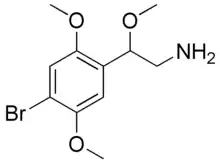BOB (psychedelic)
 | |
 | |
| Names | |
|---|---|
| Preferred IUPAC name
2-(4-Bromo-2,5-dimethoxyphenyl)-2-methoxyethan-1-amine | |
| Other names
4-Bromo-2,5,β-trimethoxyphenethylamine 2-(4-Bromo-2,5,β-trimethoxyphenyl)ethanamine | |
| Identifiers | |
CAS Number |
|
3D model (JSmol) |
|
| ChEMBL | |
| ChemSpider | |
PubChem CID |
|
| UNII | |
CompTox Dashboard (EPA) |
|
InChI
| |
SMILES
| |
| Properties | |
Chemical formula |
C11H16BrNO3 |
| Molar mass | 290.157 g·mol−1 |
Except where otherwise noted, data are given for materials in their standard state (at 25 °C [77 °F], 100 kPa). | |
| Infobox references | |
BOB (4-bromo-2,5,beta-trimethoxyphenethylamine) is a lesser-known psychedelic drug. It is the beta-methoxy analog of 2C-B. BOB was first synthesized by Alexander Shulgin. In his book PiHKAL, the dosage range is listed as 10–20 mg, and the duration listed as 10–20 hours.[1] BOB produces an altered state of consciousness, tinnitus, a pleasant tingling throughout the body, and a sense of awareness.[1] Very little data exists about the pharmacological properties, metabolism, and toxicity of BOB.
Legality
United Kingdom
This substance is a Class A drug in the Drugs controlled by the UK Misuse of Drugs Act.[2]
See also
References
- 1 2 BOB Entry in PiHKAL
- ↑ "UK Misuse of Drugs act 2001 Amendment summary". Isomer Design. Retrieved 12 March 2014.
This article is issued from Offline. The text is licensed under Creative Commons - Attribution - Sharealike. Additional terms may apply for the media files.